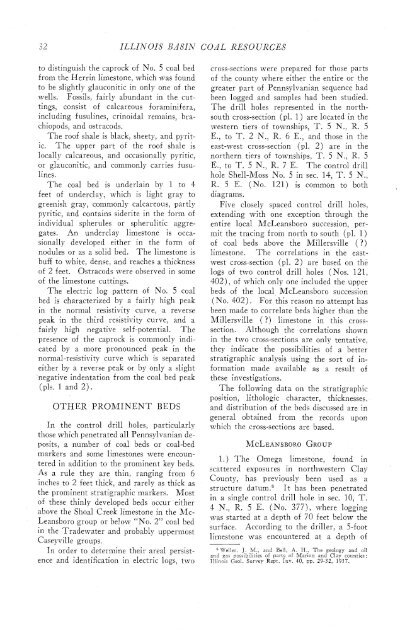subsurface geology and coal resources of the pennsylvanian system ...
subsurface geology and coal resources of the pennsylvanian system ...
subsurface geology and coal resources of the pennsylvanian system ...
Create successful ePaper yourself
Turn your PDF publications into a flip-book with our unique Google optimized e-Paper software.
32 ILLINOIS BASIAT COAL RESOURCES<br />
to distinguish <strong>the</strong> caprock <strong>of</strong> No. 5 <strong>coal</strong> bed<br />
from <strong>the</strong> Herrin limestone, which was found<br />
to be slightly glauconitic in only one <strong>of</strong> <strong>the</strong><br />
wells. Fossils, fairly abundant in <strong>the</strong> cuttings,<br />
consist <strong>of</strong> calcareous foraminifera,<br />
including fusulines, crinoidal remains, brachiopods,<br />
<strong>and</strong> ostracods.<br />
The ro<strong>of</strong> shale is black, sheety, <strong>and</strong> pyritic.<br />
The upper part <strong>of</strong> <strong>the</strong> ro<strong>of</strong> shale is<br />
locally calcareous, <strong>and</strong> occasionally pyritic,<br />
or glauconitic, <strong>and</strong> commonly carries fusulines.<br />
The <strong>coal</strong> bed is underlain by 1 to 4<br />
feet <strong>of</strong> underclay, which is light gray to<br />
greenish gray, commonly calcareous, partly<br />
pyritic, <strong>and</strong> contains siderite in <strong>the</strong> form <strong>of</strong><br />
individual spherules or spherulitic aggregates.<br />
An underclay limestone is occasionally<br />
developed ei<strong>the</strong>r in <strong>the</strong> form <strong>of</strong><br />
nodules or as a solid bed. The limestone is<br />
buff to white, dense, <strong>and</strong> reaches a thickness<br />
<strong>of</strong> 2 feet. Ostracods miere observed in so'me<br />
<strong>of</strong> <strong>the</strong> limestone cuttings.<br />
The electric log pattern <strong>of</strong> No. 5 <strong>coal</strong><br />
bed is characterized by a fairly high peak<br />
in <strong>the</strong> normal resistivity curve, a reverse<br />
peak in <strong>the</strong> third resistivity curve, <strong>and</strong> a<br />
fairly high negative self-potential. The<br />
presence <strong>of</strong> <strong>the</strong> caprock is commonly indicated<br />
by a more pronounced peak in <strong>the</strong><br />
normal-resistivity curve which is separated<br />
ei<strong>the</strong>r by a reverse peak omr by only a slight<br />
negative indentation frorn <strong>the</strong> <strong>coal</strong> bed peak<br />
(pls. 1 <strong>and</strong> 2).<br />
OTHER PROMINENT BEDS<br />
In <strong>the</strong> control drill holes, particularly<br />
those which penetrated all Pennsylvanian deposits,<br />
a number <strong>of</strong> <strong>coal</strong> beds or <strong>coal</strong>-bed<br />
markers <strong>and</strong> some limestones were encountered<br />
in addition to <strong>the</strong> prominent key beds.<br />
As a rule <strong>the</strong>y are thin, ranging from 6<br />
inches to 2 feet thick, <strong>and</strong> rarely as thick as<br />
<strong>the</strong> prominent stratigraphic markers. Most<br />
<strong>of</strong> <strong>the</strong>se thinly developed beds occur ei<strong>the</strong>r<br />
above <strong>the</strong> Shoal Cseek limestone in <strong>the</strong> Mc-<br />
Leansboro group or below "No. 2" <strong>coal</strong> bed<br />
in <strong>the</strong> Tradewater <strong>and</strong> probably uppermost<br />
Caseyville groups.<br />
cross-sections were re pared for those parts<br />
<strong>of</strong> <strong>the</strong> county where ei<strong>the</strong>r <strong>the</strong> entire or <strong>the</strong><br />
greater part <strong>of</strong> Pennsylvanian sequence had<br />
been logged <strong>and</strong> samples had been studied.<br />
The drill holes represented in <strong>the</strong> northsouth<br />
cross-section (pl. 1 ) are located in <strong>the</strong><br />
western tiers <strong>of</strong> townships, T. 5 N., R. 5<br />
E., to T. 2 N., R. 6 E., <strong>and</strong> those in <strong>the</strong><br />
east-west cross-section (pl. 2) are in <strong>the</strong><br />
nor<strong>the</strong>rn tiers <strong>of</strong> townships, T. 5 N., R. 5<br />
E., to T. 5 N., R. 7 E. The control drill<br />
hole Shell-Moss No. 5 in sec. 14, T. 5 N.,<br />
R. 5 E. (No. 121) is common to both<br />
diagrams.<br />
Five closely spaced control drill holes,<br />
extending with one exception through <strong>the</strong><br />
entire local McLeansboro succession, permit<br />
<strong>the</strong> tracing from north to south (~1. 1)<br />
<strong>of</strong> <strong>coal</strong> beds above <strong>the</strong> Millersville ( ?)<br />
limestone. The correlations in <strong>the</strong> eastwest<br />
cross-section (pl. 2) are based on <strong>the</strong><br />
logs <strong>of</strong> two control drill holes (Nos. 121,<br />
402), <strong>of</strong> which only one included <strong>the</strong> upper<br />
beds <strong>of</strong> <strong>the</strong> local McLeansboro successien<br />
(No. 402). For this reason no attempt has<br />
been made to correlate beds higher than <strong>the</strong><br />
Millersville ( ?) limestone in this cross-<br />
section. Although <strong>the</strong> correlations shown<br />
in <strong>the</strong> two cross-sections are only tentative,<br />
<strong>the</strong>y indicate <strong>the</strong> possibilities <strong>of</strong> a better<br />
stratigraphic analysis using <strong>the</strong> sort <strong>of</strong> information<br />
made available as a result <strong>of</strong><br />
<strong>the</strong>se investigations.<br />
The following data on <strong>the</strong> stratigraphic<br />
position, lithologic character, thicknesses,<br />
<strong>and</strong> distribution <strong>of</strong> <strong>the</strong> beds discussed are in<br />
general obtained from <strong>the</strong> records upon<br />
which <strong>the</strong> cross-sections are based.<br />
1.) The Omega limestone, found in<br />
scattered exposures in northwestern Clay<br />
County, has previously been used as a<br />
structure datum.' It has been penetrated<br />
in a single control dsill hole in sec. 10, T.<br />
4- N., R. 5 E. (No. 377), where logging<br />
was started at a depth <strong>of</strong> 70 feet below <strong>the</strong><br />
surface. According to <strong>the</strong> driller, a 5-foot<br />
li~nestone was encountered at a depth <strong>of</strong><br />
In order to determine <strong>the</strong>ir areal persist- "Velier, J. M., <strong>and</strong> Bell, A. I-I., The <strong>geology</strong> <strong>and</strong> oil<br />
<strong>and</strong> gas possibilities <strong>of</strong> parts <strong>of</strong> Marion <strong>and</strong> Clay counties:<br />
ence <strong>and</strong> identification in electric logs, two Tllinoi; Geol. Survey Rept. Inv. 10, pp. 29-32, 1937.
















